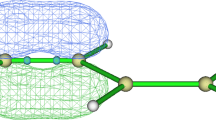Abstract
The term “σ-hole” originally referred to the electron-deficient outer lobe of a half-filled p (or nearly p) orbital involved in forming a covalent bond. If the electron deficiency is sufficient, there can result a region of positive electrostatic potential which can interact attractively (noncovalently) with negative sites on other molecules (σ-hole bonding). The interaction is highly directional, along the extension of the covalent bond giving rise to the σ-hole. σ-Hole bonding has been observed, experimentally and computationally, for many covalently-bonded atoms of Groups V–VII. The positive character of the σ-hole increases in going from the lighter to the heavier (more polarizable) atoms within a Group, and as the remainder of the molecule becomes more electron-withdrawing. In this paper, we show computationally that significantly positive σ-holes, and subsequent noncovalent interactions, can also occur for atoms of Group IV. This observation, together with analogous ones for the molecules (H3C)2SO, (H3C)2SO2 and Cl3PO, demonstrates a need to expand the interpretation of the origins of σ-holes: (1) While the bonding orbital does require considerable p character, in view of the well-established highly directional nature of σ-hole bonding, a sizeable s contribution is not precluded. (2) It is possible for the bonding orbital to be doubly-occupied and forming a coordinate covalent bond.

Two views of the calculated electrostatic potential on the 0.001 au molecular surface of SiCl4. Color ranges, in kcal/mole, are: purple, negative; blue, between 0 and 8; green, between 8 and 11; yellow, between 11 and 18; red, more positive than 18. The top view shows three of the four chlorines. In the center is the σ-hole due to the fourth Cl−Si bond, its most positive portion (red) being on the extension of that bond. In the bottom view are visible two of the σ-holes on the silicon. In both views can be seen the σ-holes on the chlorines, on the extensions of the Si−Cl bonds; their most positive portions are green


Similar content being viewed by others
References
Clark T, Hennemann M, Murray JS, Politzer P (2007) J Mol Model 13:291–296. doi:10.1007/s00894-006-0130-2
Metrangolo P, Neukirsch H, Pilati T, Resnati G (2005) Acc Chem Res 38:386–395. doi:10.1021/ar0400995
Metrangolo P, Resnati G (eds) (2008) Halogen Bonding: Fundamentals and Applications, Structure and Bonding No. 126. Springer, Berlin
Politzer P, Lane P, Concha MC, Ma Y, Murray JS (2007) J Mol Model 13:305–311. doi:10.1007/s00894-006-0154-7
Brinck T, Murray JS, Politzer P (1992) Int J Quantum Chem Quantum Biol Symp 19:57–64. doi:10.1002/qua.560440709
Murray JS, Paulsen K, Politzer P (1994) Proc Indiana Acad Sci 106:267–275 Chem Sci
Auffinger P, Hays FA, Westhof E, Shing Ho P (2004) Proc Natl Acad Sci USA 101:16789–16794. doi:10.1073/pnas.0407607101
Politzer P, Murray JS, Concha MC (2007) J Mol Model 13:643–650. doi:10.1007/s00894-007-0176-9
Wang Y-H, Lu Y-X, Zou J-W, Yu Q-S (2008) Int J Quantum Chem 108:1083–1089. doi:10.1002/qua.21583
Riley KE, Murray JS, Concha MC, Politzer P, Hobza P (2008) J Chem Theory Comput (in press)
Murray JS, Lane P, Politzer P (2007) Int J Quantum Chem 107:3046–3052. doi:10.1002/qua.21352
Murray JS, Clark T, Lane P, Politzer P (2007) J Mol Model 13:1033–1038. doi:10.1007/s00894-007-0225-4
Politzer P, Murray JS (2008) Ann Eur Acad Sci (in press)
Clark T, Murray JS, Lane P, Politzer P (2008) J Mol Model 14:689–697. doi:10.1007/s00894-008-0279-y
Stewart RF (1979) Chem Phys Lett 65:335–342. doi:10.1016/0009-2614(79)87077-3
Politzer P, Truhlar DG (eds) (1981) Chemical applications of atomic and molecular electrostatic potentials. Plenum, New York
Bader RFW, Carroll MT, Cheeseman JR, Chang C (1987) J Am Chem Soc 109:7968–7979. doi:10.1021/ja00260a006
Murray JS, Politzer P (1998) J Mol Struct THEOCHEM 425:107–114 . doi:10.1016/S0166-1280(97)00162-0
Politzer P, Murray JS (1999) Trends. Chem Phys 7:157–165
Politzer P, Murray JS (2001) Fluid Phase Equil 185:129–137. doi:10.1016/S0378-3812(01)00463-0
Hagelin H, Brinck T, Murray JS, Berthelot M, Politzer P (1995) Can J Chem 73:483–488. doi:10.1139/v95-063
Grimme S (2006) J Comput Chem 27:1787–1799. doi:10.1002/jcc.20495
Murray JS, Politzer P (2008) Croat Chem Acta (in press)
Ramasabbu N, Parthasarathy R, Murray-Rust P (1986) J Am Chem Soc 108:4308–4314. doi:10.1021/ja00275a012
Rosenfeld RE Jr, Parthasarathy R, Dunitz JD (1977) J Am Chem Soc 99:4860–4862. doi:10.1021/ja00456a072
Politzer P, Murray JS, Concha MC (2008) J Mol Model 14:659–665. doi:10.1007/s00894-008-0280-5
Bondi A (1964) J Phys Chem 68:441–451. doi:10.1021/j100785a001
Ignatyev IS, Schaefer HF III (2001) J Phys Chem A 105:7665–7671. doi:10.1021/jp0104334
Reed AE, Curtiss LA, Weinhold F (1988) Chem Rev 88:899–926. doi:10.1021/cr00088a005
Olie K (1971) Acta Crystallogr B 27:1459–1460. doi:10.1107/S0567740871004138
Author information
Authors and Affiliations
Corresponding author
Rights and permissions
About this article
Cite this article
Murray, J.S., Lane, P. & Politzer, P. Expansion of the σ-hole concept. J Mol Model 15, 723–729 (2009). https://doi.org/10.1007/s00894-008-0386-9
Received:
Accepted:
Published:
Issue Date:
DOI: https://doi.org/10.1007/s00894-008-0386-9




